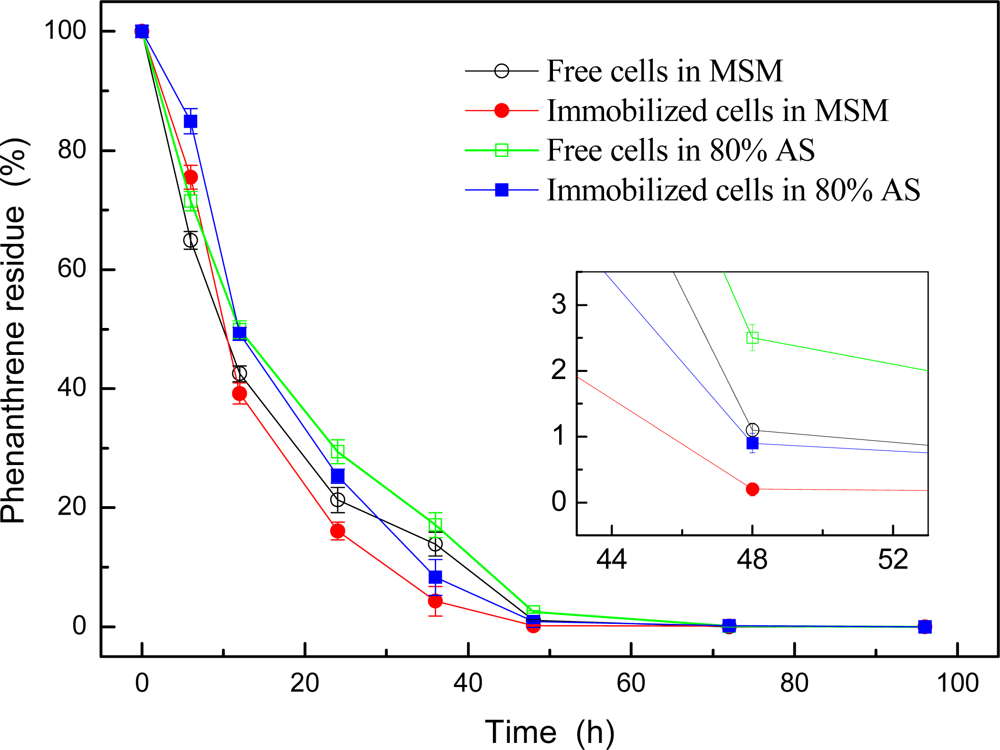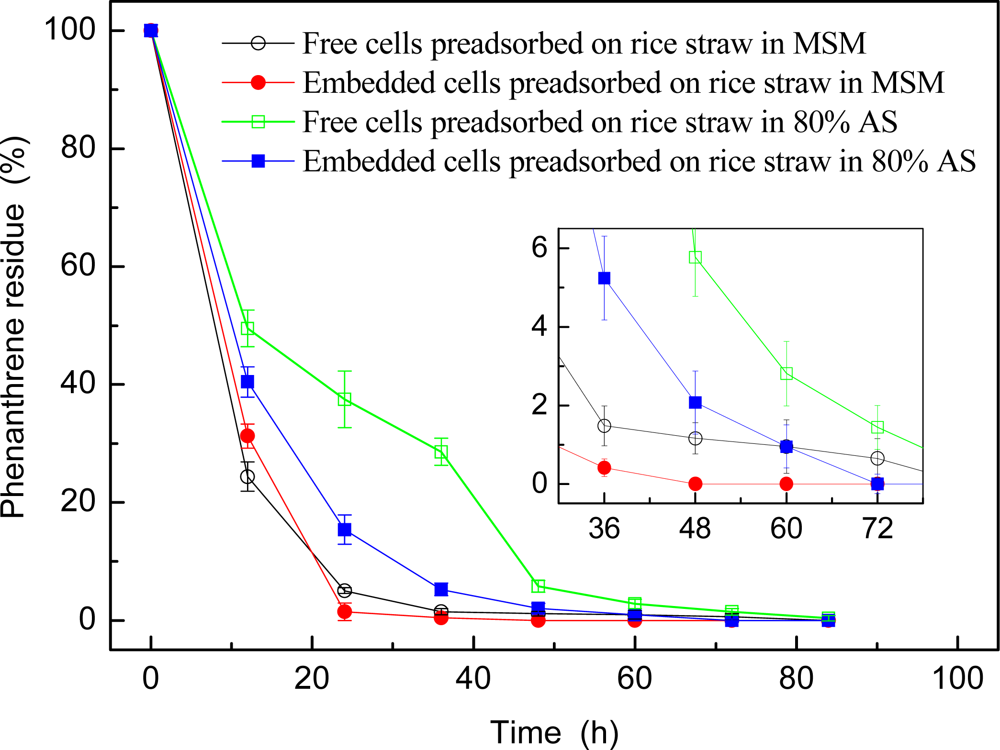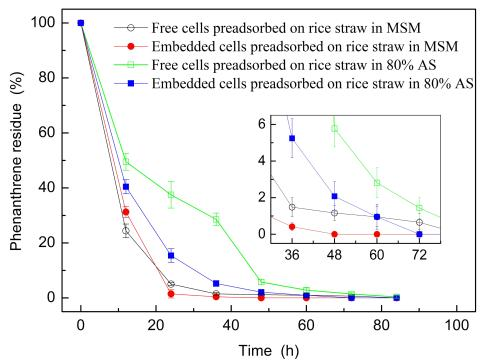Rapid Degradation of Phenanthrene by Using Sphingomonas sp. GY2B Immobilized in Calcium Alginate Gel Beads
Abstract
:1. Introduction
2. Materials and Methods
2.1. Materials and Growth Conditions
2.2. Cultivation of Microorganisms
2.3. Cell immobilization Method
2.4. Mass Transfer Performance and Mechanical Stability Tests
2.5. Biodegradation Test with Free and Immobilized Strains
2.6. Analysis Methods
3. Results and Discussion
3.1. Effect of Concentration of Na-Alginate Solution on the Beads
3.2. Phenanthrene Degradation by Embedded and Free Cells
3.3. Phenanthrene Degradation by Embedded Cells Preadsorbed on Rice Straw
3.4. Phenanthrene Degradation Rates
3.5. Potential Application of Strain GY2B
4. Conclusions
Acknowledgments
References
- Samanta, SK; Chakraborti, AK; Jain, RK. Degradation of phenanthrene by different bacteria: evidence for novel transformation sequences involving the formation of 1-naphthol. Appl. Microbiol. Biotechnol 1999, 53, 98–107. [Google Scholar]
- Cataldo, F; Keheyan, Y. Gamma-radiolysis and ozonolysis of polycyclic aromatic hydrocarbons (PAHs) in solution. J. Radioanal. Nucl. Chem 2006, 267, 679–683. [Google Scholar]
- Little, C; Hepher, MJ; El-Sharif, M. The sono-degradation of phenanthrene in an aqueous environment. Ultrasonics 2002, 40, 667–674. [Google Scholar]
- Lu, GN; Dang, Z; Tao, XQ; Yang, C; Yi, XY. Modeling and prediction of photolysis half-lives of polycyclic aromatic hydrocarbons in aerosols by quantum chemical descriptors. Sci. Total Environ 2007, 373, 289–296. [Google Scholar]
- Sirisaksoontorn, W; Thachepan, S; Songsasen, A. Photodegradation of phenanthrene by N-doped TiO2 photocatalyst. J. Environ. Sci. Heal. A 2009, 44, 841–846. [Google Scholar]
- Samanta, SK; Singh, OV; Jain, RK. Polycyclic aromatic hydrocarbons: environmental pollution and bioremediation. Trends Biotechnol 2002, 20, 243–248. [Google Scholar]
- Cerniglia, CE. Biodegradation of polycyclic aromatic hydrocarbons. Biodegradaion 1992, 3, 351–368. [Google Scholar]
- Seo, JS; Keum, YS; Li, QX. Bacterial degradation of aromatic compounds. Int. J. Environ. Res. Public Health 2009, 6, 278–309. [Google Scholar]
- Zhao, HP; Wu, QS; Wang, L; Zhao, XT; Gao, HW. Degradation of phenanthrene by bacterial strain isolated from soil in oil refinery fields in Shanghai, China. J. Hazard. Mater 2009, 164, 863–869. [Google Scholar]
- Tian, L; Ma, P; Zhong, JJ. Kinetics and key enzyme activities of phenanthrene degradation by Pseudomonas Mendocina. Process Biochem 2002, 37, 1431–1437. [Google Scholar]
- Miller, CD; Hall, K; Liang, YN; Nieman, K; Sorensen, D; Issa, B; Anderson, AJ; Sims, RC. Isolation and characterization of polycyclic aromatic hydrocarbon-degrading mycobacterium isolates from soil. Microb. Ecol 2004, 48, 230–238. [Google Scholar]
- Iwabuchi, T; Yamauchi, YI; Katsuta, A; Harayama, S. Isolation and characterization of marine Nocardioides capable of growing and degrading phenanthrene at 42 °C. J. Mar. Biotechnol 1998, 6, 86–90. [Google Scholar]
- Kang, H; Hwang, SY; Kim, YM; Kim, E; Kim, YS; Kim, SK. Degradation of phenanthrene and naphthalene by a Burkholderia species strain. Can. J. Microbiol 2003, 49, 139–144. [Google Scholar]
- Mallick, S; Dutta, TK. Kinetics of phenanthrene degradation by Staphylococcus sp. strain PN/Y involving 2-hydroxy-1-naphthoic acid in a novel metabolic pathway. Process Biochem 2008, 43, 1004–1008. [Google Scholar]
- Keum, YS; Seo, JS; Hu, YT; Li, QX. Degradation pathways of phenanthrene by Sinorhizobium sp C4. Appl. Microbiol. Biotechnol 2006, 71, 935–941. [Google Scholar]
- Leitao, AL. Potential of Penicillium species in the bioremediation field. Int. J. Environ. Res. Public Health 2009, 6, 1472–1484. [Google Scholar]
- Pinyakong, O; Habe, H; Omori, T. The unique aromatic catabolic genes in Sphingomonads degrading polycyclic aromatic hydrocarbons (PAHs). J. Gen. Appl. Microbiol 2003, 49, 1–19. [Google Scholar]
- Pinyakong, O; Habe, H; Yoshida, T; Nojiri, H; Omori, T. Identification of three isofunctional novel salicylate 1-hydroxylases involved in the phenanthrene degradation of Spingobium sp. strain P2. Biochem. Biophys. Res. Commun 2003, 301, 350–357. [Google Scholar]
- Tao, XQ; Lu, GN; Dang, Z; Yang, C; Yi, XY. A phenanthrene-degrading strain Sphingomonas sp. GY2B isolated from contaminated soils. Process Biochem 2007, 42, 401–408. [Google Scholar]
- Tao, XQ; Sun, GQ; Ou, YC; Lu, GN; Zhou, KQ. Environmental adaptability study of a phenanthrene-degrading strain. Environ Sci Manage 2008, 33, 100–103. [Google Scholar]
- Tao, XQ; Lu, GN; Dang, Z; Yi, XY; Yang, C. Isolation of phenanthrene-degrading bacteria and characterization of phenanthrene metabolites. World J. Microbiol. Biotechnol 2007, 23, 647–654. [Google Scholar]
- Gentili, AR; Cubitto, MA; Ferrero, M; Rodriguez, MS. Bioremediation of crude oil polluted seawater by a hydrocarbondegrading bacterial strain immobilized on chitin and chitosan flakes. Int. Biodeter. Biodegr 2006, 57, 222–228. [Google Scholar]
- Moslemy, P; Neufeld, RJ; Guiot, SR. Biodegradation of gasoline by gellan gum-encapsulated bacterial cells. Biotechnol. Bioeng 2002, 80, 175–184. [Google Scholar]
- Liu, YJ; Zhang, AN; Wang, XC. Biodegradation of phenol by using free and immobilized cells of Acinetobacter sp. XA05 and Sphingomonas sp. FG03. Biochem. Eng. J 2009, 44, 187–192. [Google Scholar]
- Wang, X; Gong, ZQ; Li, PJ; Zhang, LH; Hu, XM. Degradation of pyrene and benzo(a)pyrene in contaminated soil by immobilized fungi. Environ. Eng. Sci 2008, 25, 677–684. [Google Scholar]
- Zhang, K; Xu, YY; Hua, XF; Han, HL; Wang, JN; Wang, J; Liu, YM; Liu, Z. An intensified degradation of phenanthrene with macroporous alginate-lignin beads immobilized Phanerochaete chrysosporium. Biochem. Eng. J 2008, 41, 251–257. [Google Scholar]
- Sergio, AMD; Bustos, TY. Biodegradation of wastewater pollutants by activated sludge encapsulated inside calcium-alginate beads in a tubular packed bed reactor. Biodegradation 2009, 20, 709–715. [Google Scholar]
- Ha, J; Engler, CR; Wild, JR. Biodegradation of coumaphos, chlorferon, and diethylthiophosphate using bacteria immobilized in Ca-alginate gel beads. Bioresource Technol 2009, 100, 1138–1142. [Google Scholar]
- Gouda, MK. Immobilization of Rhodococcus sp DG for efficient degradation of phenol. Fresen. Environ. Bull 2007, 16, 1655–1661. [Google Scholar]
- Lyman, J; Fleming, RH. Composition of sea water. J. Mar. Res 1940, 3, 134–146. [Google Scholar]
- Pazarlioglu, NK; Telefoncu, A. Biodegradation of phenol by Pseudomonas putida immobilized on activated pumice particles. Process Biochem 2005, 40, 1807–1814. [Google Scholar]
- Wu, Z; Wang, Y; Xing, Z. Study on degrading phenol by immobilized Ralstonia metallidurans CH34. Microbiology 2005, 32, 31–36. [Google Scholar]
- Sun, XF; Sun, RC; Sun, JX. Acetylation of rice straw with or without catalysts and its characterization as a natural sorbent in oil spill cleanup. J. Agric. Food Chem 2002, 50, 6428–6433. [Google Scholar]
- Gong, RM; Jin, YB; Sun, J; Zhong, KD. Preparation and utilization of rice straw bearing carboxyl groups for removal of basic dyes from aqueous solution. Dyes Pigments 2008, 76, 519–524. [Google Scholar]
- Rocha, CG; Zaia, DAM; Alfaya, RVD; Alfaya, AAD. Use of rice straw as biosorbent for removal of Cu(II), Zn(II), Cd(II) and Hg(II) ions in industrial effluents. J. Hazard. Mater 2009, 166, 383–388. [Google Scholar]


| Na-alginate concentration | 2% | 3% | 4% |
|---|---|---|---|
| Spherical molding characteristic | Bad | Good | Excellent |
| Mechanical stability | Bad | Good | Excellent |
| Mass transfer performance | Excellent | Good | Bad |
| Smoothness | Bad | Good | Excellent |
| Resiliency | Bad | Good | Excellent |
| No. | Inoculants | Preadsorbed on rice straw | Media | Incubation period (h)b | c(0) (mg·L−1) | c(t) (mg·L−1) | PDR (mg·L−1·h−1) |
|---|---|---|---|---|---|---|---|
| 1 | Free | No | MSM | 0~24 | 100 a | 21.3 a | 3.28 ± 0.09 a |
| 2 | Immobilized | No | MSM | 0~24 | 100 a | 16.1 b | 3.50 ± 0.07 b |
| 3 | Free | No | 80% AS | 0~24 | 100 a | 29.4 c | 2.94 ± 0.09 c |
| 4 | Immobilized | No | 80% AS | 0~24 | 100 a | 25.3 d | 3.11 ± 0.05 a |
| 5 | Free | Yes | MSM | 0~24 | 100 a | 5.03 e | 3.96 ± 0.02 d |
| 6 | Immobilized | Yes | MSM | 0~24 | 100 a | 1.47 f | 4.11 ± 0.02 e |
| 7 | Free | Yes | 80% AS | 0~24 | 100 a | 37.5 g | 2.60 ± 0.16 f |
| 8 | Immobilized | Yes | 80% AS | 0~24 | 100 a | 15.4 b | 3.53 ± 0.11 b |
© 2009 by the authors; licensee Molecular Diversity Preservation International, Basel, Switzerland. This article is an open-access article distributed under the terms and conditions of the Creative Commons Attribution license (http://creativecommons.org/licenses/by/3.0/).
Share and Cite
Tao, X.-Q.; Lu, G.-N.; Liu, J.-P.; Li, T.; Yang, L.-N. Rapid Degradation of Phenanthrene by Using Sphingomonas sp. GY2B Immobilized in Calcium Alginate Gel Beads. Int. J. Environ. Res. Public Health 2009, 6, 2470-2480. https://doi.org/10.3390/ijerph6092470
Tao X-Q, Lu G-N, Liu J-P, Li T, Yang L-N. Rapid Degradation of Phenanthrene by Using Sphingomonas sp. GY2B Immobilized in Calcium Alginate Gel Beads. International Journal of Environmental Research and Public Health. 2009; 6(9):2470-2480. https://doi.org/10.3390/ijerph6092470
Chicago/Turabian StyleTao, Xue-Qin, Gui-Ning Lu, Jie-Ping Liu, Ting Li, and Li-Ni Yang. 2009. "Rapid Degradation of Phenanthrene by Using Sphingomonas sp. GY2B Immobilized in Calcium Alginate Gel Beads" International Journal of Environmental Research and Public Health 6, no. 9: 2470-2480. https://doi.org/10.3390/ijerph6092470





